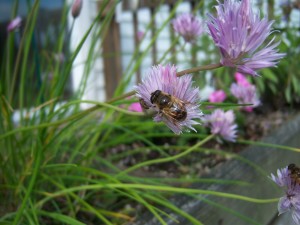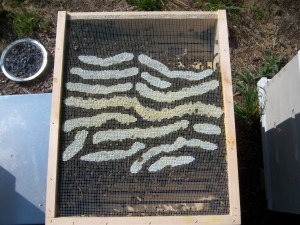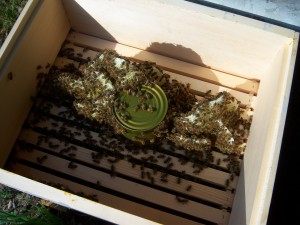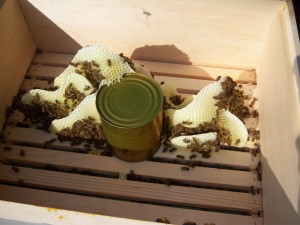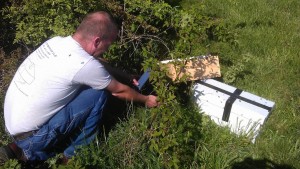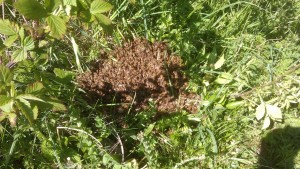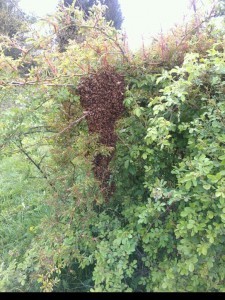Honeybees

Late June bee flowers
0Wildflowers come and go sometimes so quickly that I don’t get a chance to document what is going on. I am trying to record what the bees are visiting and when. This may be an unusual (early) year because of the warm and short winter, and that affected the spring plants greatly, but I suspect that the summer plants are mostly on schedule. Things in bloom now that the bees like include clover, wild mint, broccoli, squash, and hibiscus.

How are the bees?
0I inspected the bees a few days ago and found them in pretty good shape, but not ‘developing’ as quickly as I had hoped. The two old hives still have queen excluders on with signs of a little comb being built. Hive A is still brimming with bees and I believe that they have plenty of honey stored in the brood area. Maybe I will be able to extract some of that honey later this summer. Hive B is not as busy at the entrance nor does it seem as full inside, but is a good strong hive for this time of year. Both A and B have new queens this year.
Hive C still has the burr comb in the feeder, but without the queen excluder on it is now (I think) being filled back up with honey. I don’t think there is any brood in it, but am not sure. A few weeks ago I added a medium brood box on top of the deep and under the feeder and there is still plenty of room in that box.
Hive D is the first swarm hive which should have one of the original queens from either A or B, but I found the queen and she is not marked (both queens from A and B last year had white marks for 2011). So I am a bit stumped. Maybe that queen was superseded either before or after it swarmed. Maybe the white dots can wear off. I’m not really sure, but in any case hive D is busting out with bees. I didn’t look in the bottom brood box, so I don’t know if there were any queen cells, but I did get a queen excluder and a new medium box on top. I hope I got the new box on in time. Most of the pictures are from hive D.
Hive E is a swarm from hive C (2012 Georgian bees) and although I believe hive C swarmed twice, hive E was from the first swarm. I haven’t found the queen yet, but it should also be marked. It had a white dot when I got it in March even though it should have been yellow for 2012.

June bees and flowers
0I am always interested in what my honeybees are finding to forage on the property. They can fly three or so miles to find food, but the more I can offer them in my yard, the better. I haven’t planted a field of wildflowers yet, so the bees only have access to the native wildflowers and weeds. This June there has been a lot of clover in the grass and tons of Crown Vetch. I have seen the bees on both, but not much, so they must still be finding sources elsewhere.

May bee inspection
0I needed to move the last three hives out about two feet to have more room to move around behind the boxes. The set up was fine when there were only two hives, but when I added the three new ones this spring, I was just too cramped. It’s a daunting task, really, to move three hives forward two feed in the middle of the day. In order to do it I needed to temporarily move them to the side in order to move cinder blocks and 4 x 4 supports. When the hives are moved four feet to the side or back, the returning foragers can’t find the hive and the cloud of bees just gets thicker and thicker. So time is of the essence. I got them moved and the bees were pretty tolerant considering the disruption.
After moving hives 3, 4, and 5, I really wanted to look inside hives 1 and 5 because there was so little activity at the hive entrance that I was worried that they might be dead. They weren’t. Hive 1 (formerly Boston, and with five now I decided numbers were just going to be easier) had nothing in the honey super – no surprise there – but there certainly were bees in both deep boxes. Ok, so there are bees, but is there a laying queen. I have not seen a queen or any eggs since the hive swarmed seven weeks ago. In fact, I really hadn’t looked. I was going on faith that the hive had a new queen. The good news is that there was brood and a real live queen whom I saw after looking casually at just a few frames. You can see her in a couple of the close-ups above. That was just dumb luck. So I don’t really know why that hive has so little foraging going on, but it might have to do with the swarming and cycle of brood. At this point, I rather expect to see a large increase in the population very soon, and the young bees will soon become foragers. Time will tell.
Hive 2 has been super busy at the entrance and has more bees inside, but I didn’t inspect today.
Hive 3 was the new Georgia bee hive that I think swarmed twice. It has the comb in the feeder box above a queen excluder. The feeder box was acting like a honey super. I should have realized this, but there were lots of drones trapped in that box because they couldn’t get down through the excluder and they probably ate all the honey that had been stored there. It looked mostly empty. There is a screened cover over the feeder box, but it might not have an escape. I removed the queen excluder, mostly to let the drones out. I might just clean out the comb, the next time I inspect.
Hive 4 had a feeder box with nothing in it except a few larvae that might have been Small Hive Beetles. There was one large white larva that I removed and killed. Not sure what it was. It was 10 times the size of the small larvae.
Hive 5 had bees as it turned out, but, again, they were very quiet at the entrance. It was swarm 3, so the first of the Georgia swarms. It should, therefore, have a marked queen. As I recall, these are marked white even thought Jason Hough said they were 2012 queens which should be yellow, I think. I guess I just will never know for sure. But I should be able to find that queen and get a picture of her one of these days.
I still haven’t done anything to measure varroa, so that is another project that needs to happen soon.

Hoverflies
0The herbs on our deck are blooming including the pretty violet flowers atop the slender chive stalks. I was excited to see several of my honeybees enjoying the flowers. When I looked a little closer, they appeared to be drones (male honeybees) with their large bodies and large black eyes. Then upon even closer inspection, I decided that they weren’t bees at all. I think they were hoverflies. I found a nice website with pictures of lots of different types of hoverflies at: http://www.microscopy-uk.org.uk/mag/artmay07/cd-hoverflies.html. The ones I saw seemed a little different than all the pictures, but there is a lot of variety in this family. One of the major differences between bees and flies is that bees have two sets of wings, whereas flies have only one.
Swarm number 5
0They just keep coming … and going. I thought I had seen my last swarm, but number five left my third hive (Georgia bees installed in March) and landed on the same magic bee bush as the previous four swarms. I had just received some new woodenware, so I quickly assembled four boxes and then painted them to get them ready for the swarm. It was about three or four hours later when I went out to capture the swarm in a nuc box, but they had already departed for a new home.
I am pretty sure that the swarm had just left the hive when I saw it this morning. There were lots of bees in the air, lots around hive 3, and they seemed to be collecting on the bush. In about 15 minutes, there were noticeably fewer bees in the air and around the hive and bush. It certainly looked like they had just swarmed and settled down. However, a half hour later, I saw a waggle dance on one section of the swarm. I didn’t look on other parts of the swarm. If they had just swarmed, how could a scout be doing a waggle dance already? I don’t know. I didn’t really want another hive, but I surely didn’t want to lose another half of my Georgia bees.
The previous swarm from that hive was 19 days ago. At best the new queen has only been laying for a few days or maybe a week. Now there will be another approximately 14 days until another new queen will start laying eggs. So in two weeks, that hive will have gone about a month without new brood (possibly a few days worth of eggs in the middle). The rest of the bees will be pretty old. It seems like I should expect a population crash and slow rebuild.
This is the hive that has the burr comb in the feeding box. I looked at it today and I saw a little of it capped with honey, but lots of it looking mostly empty. I was kinda hoping that it was all going to be capped honey by now. I recently installed a new medium brood box between the deep brood box and the feeding box, hoping to prevent swarming and giving them plenty of expansion space. Apparently, I was too late.
I also moved the first two hives forward about two feet to give myself more room to work on the hives from behind. Again, I had the chance to see what was going on in the supers I put on a couple of months ago. There was still no nectar being stored there. Below the super there are two deep brood boxes. I removed the super and then the top brood box. It must have weighed 50 pounds. So no honey in the super, but a brood box with lots of honey. I didn’t look at the frames today. The second hive was similar but not as heavy – perhaps only 30 pounds in the top brood box. Both lower brood boxes were lighter than the upper boxes, but, again, I didn’t inspect further. That will be another day soon.
I need to move the three smaller hives forward, too. I might be able to just lift them intact and set them on the new stand. They are not nearly as heavy as the first two hives.

Bee neglect
2It has been an exciting spring so far. All three of my hives swarmed and a fourth swarm showed up from I know not where. The garden is getting prepared and planted. The chickens needed more space and we have two groups of peeps being raising.
What hasn’t gotten done is routine maintenance on my two year-old hives and one seven-week-old hive. There have been so many reports of swarms this year, I wonder if it was just inevitable. I thought that one could prevent swarming by continuing to give the bees the space they needed to expand, but now I am not so sure.
My year-old hives both have two deep boxes for brood and have had medium honey supers on them for over a month. There was plenty of room for more brood in those boxes, but they swarmed anyway. I thought two deeps or three mediums was kind of standard for brood space and all that was needed after that were honey boxes.
So I am now wondering if maybe there are environmental conditions that result in swarming no matter what a beekeeper does.
A swarm can be good or bad. It is bad to loose half your bees, but a natural way to make a split if you can recapture your swarm. The bees take care of making the new queen and the timing is right because the bees handle the whole affair. The swarm is good if you want to expand the bee yard for the long term, but bad for honey. In two hives with 25,000 bees each, they are pretty busy with developing brood, but in a single hive of 50,000, you have twice as many to focus on gathering nectar and storing honey. I was hoping for a lot of honey this year. Maybe it won’t happen until next year now, but instead of two hives, I now have five (I gave two of the swarms away).
So about that neglect. Maybe being more attentive would have helped prevent swarming and maybe not. But in the meantime, the third hive of Georgia bees was installed in a single medium box, swarmed and has build lots of comb in the top feeding box which you can see through the screened inner cover. I looked at it yesterday, but didn’t deal with it yet. This colony swarmed just a week ago, so the new queen is not yet laying. I am tempted to add another brood box under the feeder and put a queen excluder on it and keep the feeder box and comb intact. I’m not sure if there is any brood in it, but I am hoping not. If not, then I might be able to harvest some comb honey later in the season. A bit non-standard, but what the heck.
The last two hives to deal with are the new hives from the swarms. The swarms that I kept were from my first hive and from the Georgia bee hive. Swarm one is now hive four, and it was also put into a medium box with a spacer box to hold the left over sugar syrup from the Georgia package. This is one of the standard ways to feed bees if not using a top box feeder. The problem is if you don’t look at the hive often enough, the bees will take advantage of that space and build free comb in it as you can see in the picture. I couldn’t keep this comb, so yesterday I did have to scrape this all out. There was no brood, but lots of almost ready to be capped nectar/honey. It pained me to have to scrape this all out, because of the wasted honey and even more so because of the wasted comb. I added new frames to that open box, but now the bees will have to rebuild all that comb. Bummer.
Fourth swarm
0Today I discovered the fourth swarm in the same shrub about 50 feet from my hives. At the beginning of the year I only had two hive. I added a third on in March. How did I end up with four swarms? I don’t really know. Maybe it came from off my property, drawn by the smell of the three queens who had very recently taken up temporary residence there. Whatever the reason, it was one too many swarms for me, so I passed it along to my neighbor and president of the Frederick County Beekeepers Assoc (FCBA). It all happened so fast that I didn’t even get a picture. And if I didn’t get a picture, maybe it was just a dream and never happened at all.
I also did an inspection of my Boston hive. It has been 17 or 18 days since the swarm from Boston, and I believe that the new queen would have been able to mature and get in her mating flights by now. I didn’t see her, nor did I see any eggs or larvae, but I am not going to worry about it. I will look for her or signs of here in another week or 10 days. I did something that I might regret. I swapped the top and bottom boxes again. I did this at the beginning of the season, moving the heavier/fuller box to the bottom. This time around the top box was again the much heavier one, so I moved it back to the bottom. I’m not sure this was a good idea, so I may just inspect and not swap the Anaheim hive boxes when I get a chance to inspect them.
Swarm number three
0I recaptured a third swarm from my hives today. It took a couple of tries to get the queen into the nuc box, but they are all installed and quiet for the night. I weighed the nuc box and bees (12 lbs), and an identical nuc box without bees (5 lbs). At 3500 bees per pound, those seven pounds of bees amount to about 24,500 bees. This means that there had been perhaps 35,000 to 50,000 bees in that single medium brood box. No wonder they swarmed!
This swarm seemed about the same size as the other two and it landed on the same wild berry bush. Again, I only discovered this swarm by accident as I was walking the dogs. I believe I saw a couple of bees doing a waggle dance on the outside of the swarm, so they may have actually swarmed yesterday rather than this morning. I really appreciate these swarms that leave on the weekend. It was nice that Joni and I were both available. The swarm was about at chest height, but gathered around several intersecting branches which made freeing it up a bit more challenging than usual. It was also rather wide, so dropping it into a five-frame nuc box was tricky. I was able to free up the swarm so that it was primarily hanging onto one main branch. When I gave it a shake about two thirds of the bees ended up in the box and about a third outside the box. There was still a small cluster on the branch. This got the bees rather excited and I decided to step away to see if I had the queen. I was also stung twice. I was not wearing gloves. If I would have cut the branch down and held it closer to the box to shake, I don’t think I would have been stung. Lesson learned.
When I came back to the swarm after about 15 minutes, the bees were starting to gather back on the branch, so I cut that branch and lowered it into the box to shake off those bees. After another 15 minutes break, I felt pretty sure I had the queen, although there were still lots of bees on the outside of the box. I gave it a couple of hours this time and was finally able to get the lid on the box and then just before dark when the air had cooled and the bees were all inside, I moved the nuc box along side of the last captured swarm.
I have no top cover or bottom board for this hive although I do have a medium box and frames. The top and bottom are scheduled to ship tomorrow from Brushy Mountain Bee Farm in NC. I hope it gets shipped.
I wanted to do an inspection of my hives today, but the swarm and other chores got in the way. Hopefully I will get to it tomorrow. I peeked into the box that swarmed and there is a lot of burr comb hanging from the screened inner cover over the top feeder box. I will need to open the box to see what else is going on there, but there is a pretty good chance that the virgin queen will be coming out of her cell tomorrow if she didn’t emerge today. I don’t want to damage her.
I also peeked into the top of the year old hives. They have had honey supers on them for a month, but there is still not even any comb drawn in either. Losing swarms from both of these hives has probably hurt my chances for a big honey yield this year.

Two swarms this weekend
0Despite my efforts to expand my two beehives and provide more room for my bees coming out of the winter, both hives swarmed this past weekend. I was home Friday to find the first one, but was out of town when the second hive swarmed yesterday. I called Ed (what else does one do in this situation but call his local beemaster), and he and Joni, who was home and spotted the swarm, saved the day.
We all are coming to realize how very unusual this winter was. We know it was mild, but we really didn’t know how exceptional this spring was going to be. I started feeding early, hoping that we didn’t end the winter with a late hard freeze. I also stopped feeding early and added a honey super to both of my not-quite-year-old hives hoping that the nectar would be flowing. I now suspect that all this worked out maybe too well. I don’t know if adding the honey supers had any impact at all on the decision to swarm or not. In any case the brood boxes were about 80 – 90 percent full of drawn comb and about 60 – 70 percent full of brood with a little nectar and honey and pollen here and there. My guess is that they had already decided to swarm when I put on the honey supers.
I had not yet done a complete inspection of the hives. I did swap top and bottom boxes on both hives about five weeks ago. I looked at many of the frames and liked what I saw. But since then I had not inspected the bottom boxes, so didn’t really know if there were any queen cells forming. Apparently there were.
So on Friday I didn’t see the swarm emerge, but did hear and finally spot the swarm around mid day. The swarm was on the ground. I called Ed in a panic and he generously offered to come help. We put a medium box on the ground and added five virgin frames sprayed with sugar water. We then put a cover on top and waited a half hour or so. The hope was that the queen and her entourage would climb up onto the sugary frames and hang out for a bit. When we got back to the box, we transferred the five frames into a cardboard nuc, put on the lid, and pulled the plug out on the end. I just finished reading Liz’s account of rescuing a swarm from Rose’s farm, and as she also commented, it is just an amazing sight. The swarm will follow the queen. We immediately saw the march of bees still on the ground into the box, so we know the queen was in the box. Had they all been marching out of the box we would have know that the queen was still out of the box. As is usually the case, the bees tell you everything you need to know.
I was feeling lucky that this happened on Friday because I was driving down to Roanoke the following morning for the weekend. About an hour after arriving in Roanoke, Joni called me in a panic saying that the second hive was swarming! She actually saw the swarm leaving the hive, swirling into the air. She ran into the house to call me and when she got back outside, the swarm had already mostly settled onto the other side of the same shrub that the first swarm had found. Although I was now an expert swarm catcher (having earned my cred the previous day), I was out of town, so what was there to do, but call Ed again. He once again kindly came over to help. This swarm was at chest height and after the first shake, the bees were returning to the branch. No queen. So after a snip and a better shake into the nuc, the bees were marching in as fast as they could manage. Success! Joni filmed the whole affair with Ed’s iPad and I will post that when I got it.
I don’t have the official count, but I think Ed was involved in capturing about five or six swarms this weekend alone. It has been quite a spring.


































